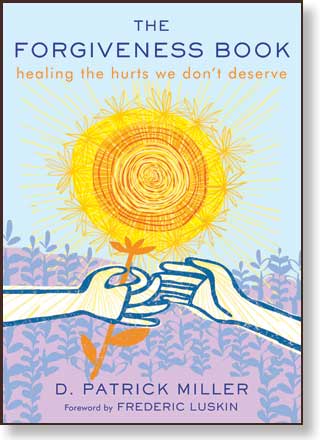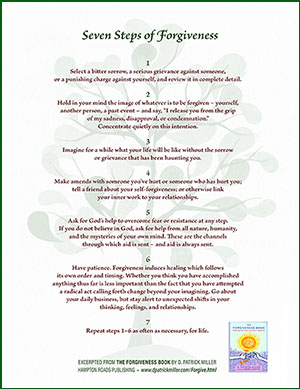Seven Steps
of Forgiveness
 What follows is the "expanded version" of the Seven Steps of Forgiveness appearing in my Hampton Roads title The Forgiveness Book: healing the hurts we don't deserve. (At the bottom of this page, you can download a printable short version.)
What follows is the "expanded version" of the Seven Steps of Forgiveness appearing in my Hampton Roads title The Forgiveness Book: healing the hurts we don't deserve. (At the bottom of this page, you can download a printable short version.)
Every one of these steps can be enhanced or accelerated with the use of a journal. At times of crisis in my own life, I have written book-length journals strictly for my own use in transcending the challenges I was facing. A forgiveness journal doesn’t have to be full of nice sentiments. In fact, for long stretches it may be just the opposite, as you allow the full expression of every feeling or idea that is standing in the way of your growth or happiness. Other forms of expression — music, painting, dance, toothpick sculptures — may also help you illuminate your own process of forgiveness. I’ve learned that creativity always follows in the wake of forgiveness, even if you don’t see the connection at first.
Forgiveness is not about being or sounding good. It’s about recognizing that everything in your experience which seems less than good can be seen differently, and ultimately transformed. But first you have to recognize everything, good and bad, that makes up the whole of what you are. Great challenges may stop you in your tracks for a while. But if you meet them with forgiveness, you will eventually find yourself propelled forward again with an inspiration that may properly be called divine.


1
Select a bitter sorrow, a serious grievance against someone, or a punishing charge against yourself, and review it in complete detail.
If you are holding a grudge or nursing a long-held sorrow, you may have actually forgotten some of the details of the event or circumstances that created the problem. Behind the chronic attachment to any particular pain is often an incomplete story. For instance, you may not be looking at the problem from all sides — especially the side of anyone who seems to have perpetrated something against you. To look at things from the side of your "enemy" is not to sympathize against yourself, but to understand more clearly how someone came to do what they did. When you begin to grasp someone else’s logic (however flawed it may be), your wisdom is increased, and you will be gifted with new insights and solutions for change.
Whatever you do, watch your dreams over the weeks and months to come. When you consciously activate the process of forgiveness, your unconscious will go to work as well, and some startling new insights may soon surface.

2
Hold in your mind the image of whatever is to be forgiven — yourself, another person, a past event — and say, "I release you from the grip of my sadness, disapproval, or condemnation." Concentrate quietly on this intention.
In most cases, what prolongs our psychic pain is not what actually happened to us in the past, but the particular way in which we are holding onto it — that is, the "grip" on the past that we have come to maintain without realizing it. To release that grip is not to forget what happened, or to make excuses for yourself or another person. Instead, it means relaxing your mental and emotional fixation on the pain, in order to let another kind of energetic response arise within you. When you first attempt this step, you may experience resistance within yourself. In fact, it would be surprising if you didn’t. However much resistance arises, don’t struggle with it; just note it and let it be, then try the step again later. This step succeeds every time you attempt it, because it is only about establishing your intention to forgive. Repeating and renewing that intention gives it increasing power. You don’t have to make it work; the intention to forgive eventually transforms your awareness on its own. Or as A Course in Miracles puts it, forgiveness "is still, and quietly does nothing... It merely looks, and waits, and judges not."

3
Imagine for a while what your life will be like without the sorrow or grievance that has been haunting you.
Part of any chronic disturbance about the past is the resentful belief that our future has been damaged or limited. While your physical or material circumstances can certainly be changed or permanently affected by something that happened to you, the quality of your consciousness at any given moment is always up to you. If you are haunted by the past, then the part of your mind that holds your future will be dim and ghostly. If you can imagine being free of anger and grief, then the future can lighten up. Do not confuse this step with wishful thinking or wistful fantasizing. It requires taking a break from negative habits of thinking, and assessing your potential as a person liberated by forgiveness. A practical way to do this is to make a list of what you could do if you were free:
If I were not sad or angry about _____,
then I would be able to...
and then write down whatever comes to mind, in terms of your untapped potentials or blocked capacities. Keep the list handy so that you can add to it whenever a new possibility occurs to you. You may be surprised at some of the ideas that crop up, and all the untapped powers that are waiting in the wings of your awareness. Who knows — the list of your potentials may become so inviting that you can’t resist bringing them to life!

4
Make amends with someone you’ve hurt or someone who has hurt you; tell a friend about your self-forgiveness; or otherwise bring your inner work to your relationships.
The first stage of forgiveness may be entirely interior, as you refocus your mind on a new way of thinking and perceiving. This stage should not be rushed. But eventually you will reach a point where you need to carry your inner work into your relationships. This can be as simple as telling someone that you’d like to bring peace to an argument you’ve been having, or apologizing for something you’ve said or done. You can say this in person, make a call, or write a letter. Whatever your approach may be, this step must be firmly grounded in the realization that everyone gains from the process of forgiveness.
Yet you should not be impatient for a miraculous shift in the quality of an aggrieved relationship. Another person may not be as ready to forgive and move on as you are — or you may discover that there is something missing or unfinished in your own approach. Forgiveness is a constant reeducation, and that process is often accelerated in the presence of anyone with whom you have issues of anger, sadness, or disappointment. Even when you are working solely on forgiving yourself, it can be very helpful to have someone in whom you can confide your realizations and changing point of view. Over time, you may feel inspired to share what you are learning with a group, a social network, or an audience. You might even end up writing a book.

5
Ask for God’s help to overcome fear or resistance at any step. If you do not believe in God, ask for help from nature, humanity, and the mysteries of your own mind. These are the channels through which aid is sent — and aid is always sent.
Forgiveness is a spiritual process, but by no means does it have to be pursued in a religious context. When you have a comfortable relationship with a divine intelligence that you may call God, then the idea of asking for help from beyond yourself will already be familiar. If not, then you may find this kind of resource in nature. In my book you will find three references to experiences in nature that helped me transcend the difficulties of forgiveness when it felt like slow going. You may also turn to trusted friends and advisors, art or literature, a meditation practice, or the suggestions of your own dreams. When you begin to look for help in forgiving, you will tend to discover allies and resources of which you were previously unaware.
The reason that "aid is always sent" is because forgiveness is a request that answers itself. I’ve come to believe that forgiveness is actually an instinct, long-buried in many people but nonetheless ready to come to the fore when summoned. Forgiveness is not quite the same as love, but it does open the door to love. When that door has been opened and you are ready to step over the threshold, you will recognize that you have finally returned home.

6
Have patience. Forgiveness induces healing which follows its own order and timing. Whether you think you have accomplished anything thus far is less important than the fact that you have attempted a radical act that will call forth change likely to exceed your expectations. Go about your daily business, but stay alert to unexpected shifts in your thinking, feelings, and relationships.
Forgiveness is a mystical process. That means it works on many levels of our psyches and relationships at once, some of which we will not be aware. I’ve noticed that when I’ve been working for a while with a "big" forgiveness issue on which I don’t seem to be making much progress, then some of the less significant problems of my life get easier or disappear entirely. It’s as if forgiveness is a kind of aspirin that’s not strong enough to stop a migraine, but takes care of some other nagging aches and pains nonetheless.
But I think what’s really happening is that the process of learning to forgive is enabling me to release some of the smaller annoyances of life while I keep holding on to bigger problems — until I understand that I really don’t need any of those problems to know who I am. Thus, it’s important to remember that inviting forgiveness into your mind always has effects, even if you are not aware of them for a while. It’s not so much a matter of having faith in forgiveness, as being open to change and surprise.
Just as you can sometimes see a dim cluster of stars more clearly by looking off to the side than directly at it, you may first become aware of forgiveness working on the edges of your self-awareness. Sooner or later, forgiveness will seep through to your center.

7
Repeat steps 1 through 6 as often as necessary, for life.
Forgiveness is an ongoing process, not a singular achievement. As you gain experience, you may apply the steps I’ve provided in a different order and with different kinds of emphasis, and you will no doubt invent more steps or even shortcuts of your own. Although forgiveness can feel awkward and unnatural when first undertaken, over time it becomes a new way of relating to people and to the unpredictable course of one’s life. Then it becomes less necessary to practice forgiveness as a discipline, because it has become a natural response to every difficulty.
I’m sometimes surprised nowadays when I see people reacting with anger to minor annoyances or unexpected events, and I realize that years ago I would have reacted similarly — but not now. That’s not because I’ve become a saint (or resigned to fate), but because I can more easily integrate the twists and turns of life and relationships than I used to. Paradoxically, the more you develop a forgiving demeanor, the less there is to forgive.

